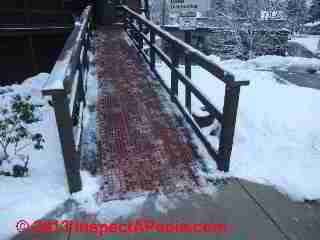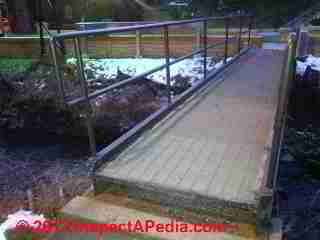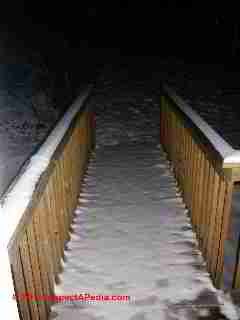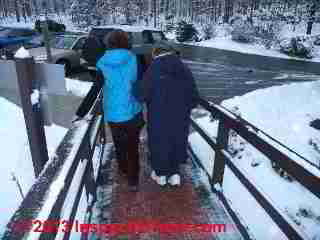 Building Access Ramps Accidents: Access ramp slips, trips, falls
Building Access Ramps Accidents: Access ramp slips, trips, falls
- POST a QUESTION or COMMENT about building access ramp construction codes, specifications, hazards, & safety improvements
Building access ramp slip and fall hazards, general safety and proper construction: this article describes the common causes of access ramp accidents: slips, trips, and falls. Slippery walking surfaces combine with inadequate handrails or guardrails to cause falling accidents along ramps and similar elevated walkways.
InspectAPedia tolerates no conflicts of interest. We have no relationship with advertisers, products, or services discussed at this website.
- Daniel Friedman, Publisher/Editor/Author - See WHO ARE WE?
Common Causes of Building Access Ramp Slip Trip & Fall Hazards

Our ramp and guardrail photo (left, Poughkeepsie, NY) illustrates that ramps are used as crossways or footbridges as well as direct building access ramps. This ramp is placed level and crosses a small creek on a college campus.
The guidelines for guardrailings and slip protection apply to these structures as well.
[Click to enlarge any image]
With its open steel grid walkway this ramp is quite slip resistant under most weather conditions. Notice that the guardrailings include the required extensions at the entry to the ramp.
SLIPS, TRIPS, Missteps and Their Consequences, by Bakken et als. and found in our references at the end of this article provides clear and well-thought out explanations of how and why people slip and fall on stairs, walks, and ramps.
Section 20.2 in Bakken et als. discusses ramp design specs and falls on ramps. The following quotes are excerpted & adapted from that text:
Principal Causes of Ramp Falls:

Most ramp falls are related to the ramp being too steep or slippery. Such conditions are often exacerbated when the
ramp is wet or accumulated debris is present. -- op cit p. 199:
People sometimes tend to move faster when walking downward on ramps due to the increased forward momentum created by the slope.
Our photo (left) shows a snow and ice-covered access ramp at the entry to a private home.
Ramps should have even greater slip-resistant surfaces than level walking surfaces, such as sidewalks, which are typically in the range of 0.65 SCOF.
While a pedestrian can more easily judge her or his slower and more deliberate speed on a staircase, it is sometimes more difficult to realize that one is increasing speed when descending an unfamiliar ramp, hence a propensity to forward-moving falls while descending ramps. -- op cit.
Static Coefficient of Friction - How Slippery is the Slope of Your Ramp?
In the cited text and other engineering references, SCOF is the static coefficient of friction. Page 23 in the above text gives the SCOF requirements for slopes of various inclines.
A 1 in 12 slope, which is an 8.3 percent slope (the recommended pitch by most sources) is bracketed by SCOFs for two slopes: a 0.93 SCOF for a 9.3 percent slope, and SCOF of 0.625 for a 6.25 percent slope.
Watch out: the slipperiness of a ramp varies enormously depending on what is on its surface, including algae, sand, dust, dirt, water, snow, ice, and even some add-on walking surfaces and paints.
At SLIPPERY STAIRS, WALKS, ROOFS we discuss the SCOF for wet algae-covered surfaces.
Visual Clues Affect the Chances of Falling on a Ramp

A pedestrian's perception of the walking surface is critical in the causality of slip incidents.
If a person perceives a "reasonably safe" walking surface, one which provides a reasonable level of slip resistance, he or she will adjust her gait accordingly on the basis of this contemporaneous tactile and/or visual input.
If a person's perception is not augmented by other internal or external warning stimuli, and if the person encounters a portion of the walking surface at heel strike that provides a SCOF below the traction demand, a slip will most probably occur.-- op cit.
In other words, using an improper and ineffective "anti slip" coating (such as ordinary paint) might actually increase the risk of falling not only for being a potentially surprise slip surface itself, but also because the presence of such a coating provides a visual clue that would be expected to lead a pedestrian to think that the surface had *extra* slip resistance when in fact it does not.
Be certain that any anti-slip paints or add-on non-slip tread materials used on a ramp are intended for that use.
The text also includes material on ramp railings (that can be a visual clue about ramp height, slope, and dangers), and on other ramp markings as they also affect ramp safety.
...
Continue reading at RAMP SLIP TRIP FALL REDUCTION or select a topic from the closely-related articles below, or see the complete ARTICLE INDEX.
Or see these
Recommended Articles
- ACCESSIBLE DESIGN
- ADA STAIR & RAIL SPECIFICATIONS
- BATHROOM DESIGN, ACCESSIBLE
- CUSTOM TOILETS
- DISABLED or ELDERLY-USE TOILETS
- ELDERLY & VETERANS HOME SAFETY
- KITCHEN DESIGN, ACCESSIBLE
- RAMPS, ACCESS - home
- RAMP CODES & STANDARDS
- RAMP LANDING CODES
- RAMP RAILING CODES
- RAMP SLOPE or PITCH
- RAMP SLIP TRIP FALL HAZARDS
- RAMP SLIP TRIP FALL REDUCTION
- STAIR DESIGN for SENIORS
- STAIRWAY CHAIR LIFTS
- SLIPPERY STAIRS, WALKS, ROOFS - Algae, Ice, Fungus, Wet Surfaces & Other Stair Slip, Trip & Fall Hazards
- STAIR CODES & STANDARDS
- TILED WALKING SURFACE SLIP HAZARDS
Suggested citation for this web page
RAMP SLIP TRIP FALL HAZARDS at InspectApedia.com - online encyclopedia of building & environmental inspection, testing, diagnosis, repair, & problem prevention advice.
Or see this
INDEX to RELATED ARTICLES: ARTICLE INDEX to STAIRS RAILINGS LANDINGS RAMPS
Or use the SEARCH BOX found below to Ask a Question or Search InspectApedia
Ask a Question or Search InspectApedia
Try the search box just below, or if you prefer, post a question or comment in the Comments box below and we will respond promptly.
Search the InspectApedia website
Note: appearance of your Comment below may be delayed: if your comment contains an image, photograph, web link, or text that looks to the software as if it might be a web link, your posting will appear after it has been approved by a moderator. Apologies for the delay.
Only one image can be added per comment but you can post as many comments, and therefore images, as you like.
You will not receive a notification when a response to your question has been posted.
Please bookmark this page to make it easy for you to check back for our response.
IF above you see "Comment Form is loading comments..." then COMMENT BOX - countable.ca / bawkbox.com IS NOT WORKING.
In any case you are welcome to send an email directly to us at InspectApedia.com at editor@inspectApedia.com
We'll reply to you directly. Please help us help you by noting, in your email, the URL of the InspectApedia page where you wanted to comment.
Citations & References
In addition to any citations in the article above, a full list is available on request.
- Stephenson, Elliott O., THE ELIMINATION OF UNSAFE GUARDRAILS, A PROGRESS REPORT [PDF] Building Standards, March-April 1993
- "Are Functional Handrails Within Our Grasp" Jake Pauls, Building Standards, January-February 1991
- Access Ramp building codes:
- UBC 1003.3.4.3
- BOCA 1016.3
- ADA 4.8.2
- IBC 1010.2
- Access Ramp Standards:
- ADA (Americans with Disabilities Act), Public Law 101-336. 7/26/90 is very often cited by other sources for good design of stairs and ramps etc. even where disabled individuals are not the design target.
- ANSI A117.4 Accessible and Usable buildings and Facilities (earlier version was incorporated into the ADA)
- ASTM F 1637, Standard Practice for Safe Walking Surfaces, (Similar to the above standards)
- Slips, Trips, Missteps and Their Consequences, Second Edition, Gary M. Bakken, H. Harvey Cohen,A. S. Hyde, Jon R. Abele, ISBN-13: 978-1-933264-01-1 or ISBN 10: 1-933264-01-2, available from the publisher, Lawyers & Judges Publishing Company,Inc., www.lawyersandjudges.com sales@lawyersandjudges.com
- Falls and Related Injuries: Slips, Trips, Missteps, and Their Consequences, Lawyers & Judges Publishing, (June 2002), ISBN-10: 0913875430 ISBN-13: 978-0913875438
"Falls in the home and public places are the second leading cause of unintentional injury deaths in the United States, but are overlooked in most literature. This book is unique in that it is entirely devoted to falls. Of use to primary care physicians, nurses, insurance adjusters, architects, writers of building codes, attorneys, or anyone who cares for the elderly, this book will tell you how, why, and when people will likely fall, what most likely will be injured, and how such injuries come about. " - Slips, Trips, Missteps and Their Consequences, Gary M. Bakken, H. Harvey Cohen, Jon R. Abele, Alvin S. Hyde, Cindy A. LaRue, Lawyers and Judges Publishing; 2 edition (April 2006), ISBN-10: 1933264012 ISBN-13: 978-1933264011
- Steps and Stairways, Cleo Baldon & Ib Melchior, Rizzoli, 1989.
- The Staircase, Ann Rinaldi
- Common Sense Stairbuilding and Handrailing, Fred T. Hodgson
- The Art of Staircases, Pilar Chueca
- Building Stairs, by pros for pros, Andy Engel
- A Simplified Guide to Custom Stairbuilding, George R. Christina
- Basic Stairbuilding, Scott Schuttner
- The Staircase (two volumes), John Templar, Cambridge: the MIT Press, 1992
- The Staircase: History and Theories, John Templar, MIT Press 1995
- Steps and Stairways, Cleo Baldon & Ib Melchior, Rizzoli, 1989.
- "The Dimensions of Stairs", J. M. Fitch et al., Scientific American, October 1974
- In addition to citations & references found in this article, see the research citations given at the end of the related articles found at our suggested
CONTINUE READING or RECOMMENDED ARTICLES.
- Carson, Dunlop & Associates Ltd., 120 Carlton Street Suite 407, Toronto ON M5A 4K2. Tel: (416) 964-9415 1-800-268-7070 Email: info@carsondunlop.com. Alan Carson is a past president of ASHI, the American Society of Home Inspectors.
Thanks to Alan Carson and Bob Dunlop, for permission for InspectAPedia to use text excerpts from The HOME REFERENCE BOOK - the Encyclopedia of Homes and to use illustrations from The ILLUSTRATED HOME .
Carson Dunlop Associates provides extensive home inspection education and report writing material. In gratitude we provide links to tsome Carson Dunlop Associates products and services.

